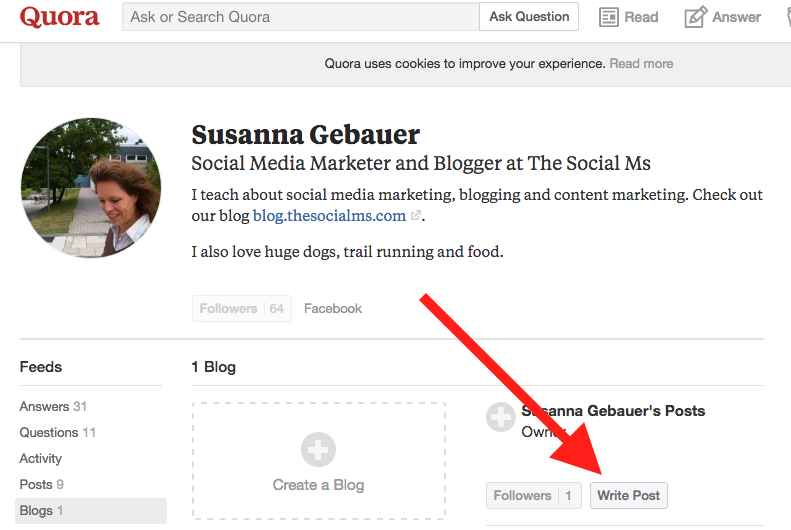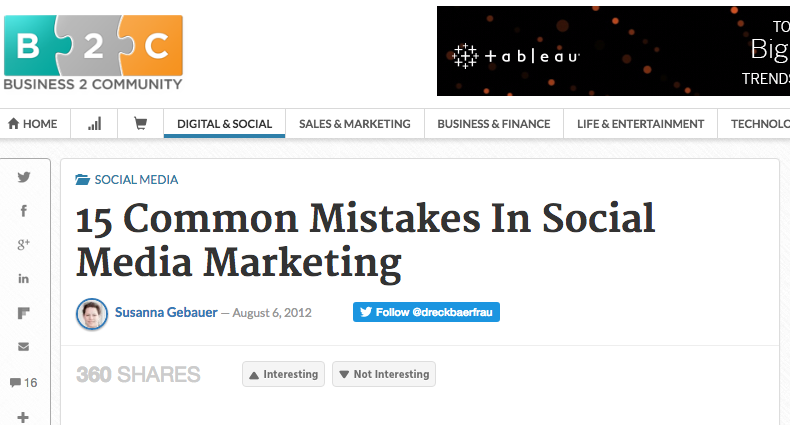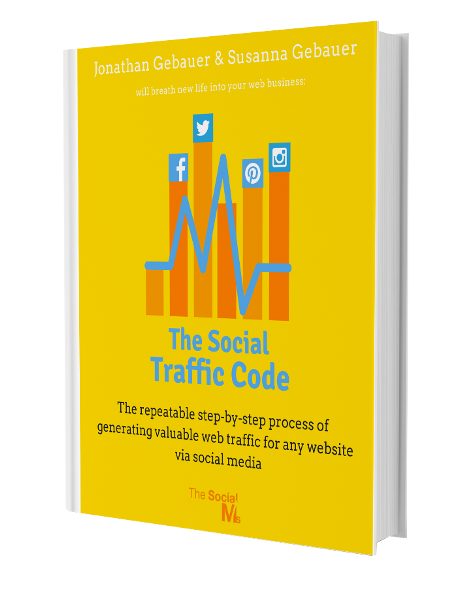First, let us make clear what content syndication is and what it is not, or should not be. Syndicating your content means that you take a piece of YOUR content that you already published on your own website or blog and republish it somewhere else. When you republish your content you say so openly, for instance, you write a sentence like „This article originally appeared on YOUR WEBSITE“ and link to it.
Syndicating is NOT copying content that does not belong to you. If you republish content that you don’t own without explicit permission of the owner of the content that is still stealing – even if you do so in another language.
That means if you want to try yourself at syndicating content, you need content in the first place.
There is a bit of a controversial discussion going on about syndicating content. But it really should not. So let us make this clear before we go right in: Google does not mind you syndicating your old content. Google is well able to identify the first place a piece of content was published and will pay the due respect to it. If you want to be on the safe side, make sure the newer piece of content links back to the original piece that should be enough to let Google identify which one was first.
Before you read on - we have various resources that show you exactly how to use social networks to gain massive traffic and leads. For instance, check out the following:
FREE Step-by-Step Twitter Marketing GuideFREE Pinterest Marketing Ebook
Why should you consider Syndicating content?
The main reasons why syndicating content is good is that you get an additional audience for content you already have. This way the impact you reach with one piece of content will be bigger. Especially when you are starting out with a new blog or website, the syndicated content can well draw more attention than the original piece. That may seem a bit frustrating, but when you are building a reputation for yourself, you are looking for exposure – and syndication can provide some exposure for free.
 In addition, you get a link to your website. There are several ways you get a link: Your bio on the website where you syndicate your content will usually include a link to your blog or website. You can link within your article to other pieces of content – if the links add value to the content. And adding a sentence that this piece of content was originally published on your blog will also give you a link.
In addition, you get a link to your website. There are several ways you get a link: Your bio on the website where you syndicate your content will usually include a link to your blog or website. You can link within your article to other pieces of content – if the links add value to the content. And adding a sentence that this piece of content was originally published on your blog will also give you a link.
These links are often not of the highest quality – but they do count for SEO. Especially when you are starting out with blogging these small links that appear on a regular basis are a great way to start your link building.
What is the difference to Guest Blogging
Guest blogging means you need to write an original piece of content that you have never published anywhere before. That means guest blogging is a lot of additional content writing.
Syndicating content means you use existing content and republish it on another outlet. Although best practice suggests that you should consider using a new title and rewriting the introductory paragraph, syndication simply is a lot less work than coming up with original pieces of content for each guest post.
On the other hand, the added work you put into guest blogging will often give you a higher value back link.
Where can you syndicate your content
While there are often outlets for various topics or niches, there are some platforms that almost anyone can use to syndicate content. They all have their ups and downs. Not all content has the optimal structure and form for all of the outlets. But you should be able to find a place where you can start your content syndication.
1. LinkedIn
Have you thought about LinkedIn as a content outlet where you can publish to an interested and targeted audience? You should!
Hey, before you read on - we have in various FREE in-depth guides on similar topics that you can download. For this post, check out:
FREE workbook: CREATE AWESOME BLOG POSTSFREE Beginner's Guide: START A BLOG
The audience you find on LinkedIn may not be the largest but it usually is a very targeted and interested audience. Before you publish, browse around LinkedIn articles and see what you find, what gets a lot of engagement. Try to get an idea of what kind of content and headlines work well on LinkedIn.
Often a very specific topic finds a larger audience. Choose your headline with care – a good headline can well get your post to success. As with other platforms, lists and how to posts often work well on LinkedIn. Publish your article when you think most of your target group could be active on LinkedIn – since LinkedIn is business focused that often is not on Weekends.
2. Medium
Many people use Medium to publish content for various reasons. Bloggers publish content that does not quite fit the scope of their blog or entrepreneurs who don’t have a blog.
The advantage of Medium is that it is fairly easy to find an audience. If you connect your Twitter and Facebook accounts, Medium will automatically connect your Medium profile to the part of your followers and friends that have an account on Medium. This way you rarely start at zero.
The audience on Medium is often very engaged and you may well see a lot more reactions to your syndicated posts than you see on your blog when you are just starting out.
So why are you not using medium instead of your blog in the first place: You will not own Medium. If you are after the long-term success that includes building an audience and turning them into leads and customers you need your own blog that you own and where you are free to do as you like.
3. BuzzFeed
Did you know that everybody can publish on the buzz-creating click baiting outlet BuzzFeed? Yes, you can.
But to go for any kind of success on BuzzFeed you need to consider the type of content that usually runs well on BuzzFeed.
Most of the time it is either lists or a type of content that shocks or surprises. You will also need some images for instance memes or funny images.
While you can easily publish almost anything on Buzzfeed, to make it worth the efforts you have to choose your content and headline with care, add images and make sure your content is easy to skim.
You should also try to get some initial exposure to your article – make sure you share it on your social accounts.
Every piece of content you publish will automatically appear in the Just Launched section, but the real success comes when a community editor chooses to promote your content. That is where the Buzz starts.
You need to stand out: Choose a topic that is not already covered to total boredom on the web. And make sure you tick the ‘Suggest for a community feature’ before you hit publish. In that case, an editor will take a look at your piece within 48 hours.
Success on Buzzfeed will probably take a little research – and creativity.
4. Quora
Are you thinking of Quora just of a website for questions and answers? There is more. Apart from Quora being a great source of inspiration for bloggers and content creators, you can publish content on Quora in the „blogs“ section.
As the other platforms in this post, Quora comes with an active, engaged and interested audience. Quora connects content to Quora „blogs“ via related keywords. This way if someone looks for information on a certain question he/she may well be led from the question to your „blog.“ That makes the audience you can reach on Quora a very interested one.
5. Business2Community
This outlet is a little different from the others as you have to apply to become a contributor. If they accept you as a contributor you can consider connecting your blog to Busines2Community so that syndication will become a lot easier.
Not every niche is a good fit for Business2community – the topics are rather B2B or business focused.
A couple of years ago almost all major social media marketing blogs syndicate ALL their blog posts to Business2Community and even today, bloggers like Jeff Bullas syndicate to Business2Community on a regular basis.
If your content resonates with the B2C community there is a lot of power in it to reach a huge audience. One of my guest posts on Jeff Bullas blog was syndicated to Business2Community and got even more engagement and attention there than on Jeff Bullas’ blog.
Final words on syndicating your content
There is a lot of power in syndicating content. You will find an additional audience and build brand and recognition for yourself and your brand. And all that while you use content that you already have. That makes content syndication a winning strategy.
Especially when you are starting out, getting your awesome content in front of a larger audience is key to success and by no means easy. Content syndication allows you to repurpose your content and distribute it to a larger audience while at the same time earning some new links back to your website.
Try it! There is nothing you can lose!
Are you active in social media marketing? Then you are probably looking for traffic from social media to your blog or website.
Do you want to see results fast? Do you want to scale your traffic and grow your business?
That can be a lot easier than you thought.
You can follow the exact process that we used to grow our traffic to a new blog from zero to 50k visitors per month in just 6 months. And you can get easy to follow step-by-step instructions to see the same kind of traffic success – all with free traffic, no advertising involved.
Check out “The Social Traffic Code!”
With this book, you will get the chance to build your own success and get huge amounts of targeted traffic from social media to any website.












